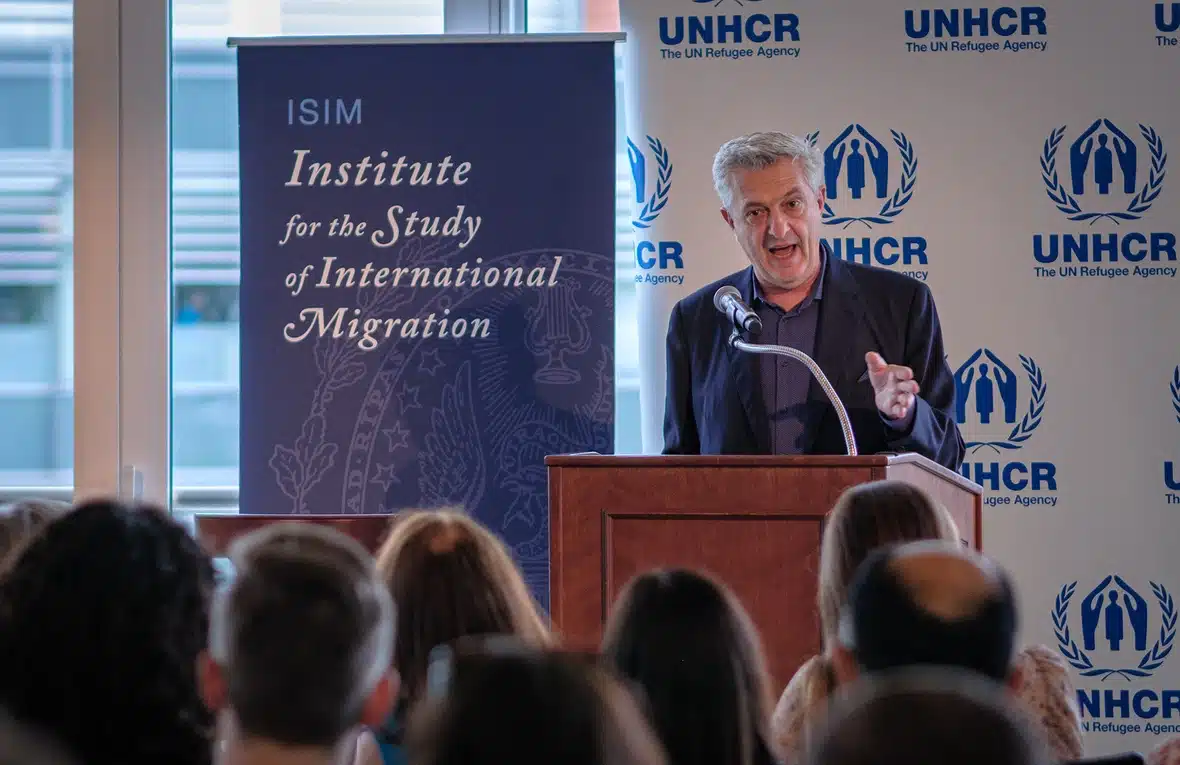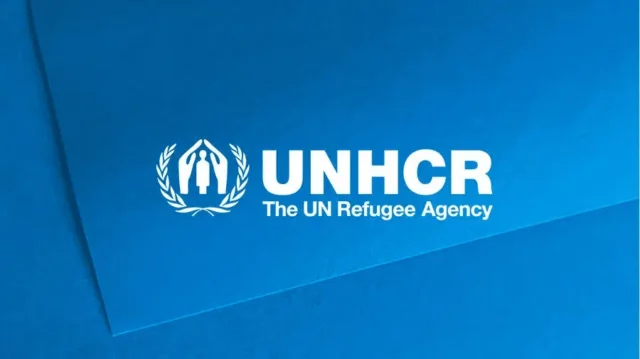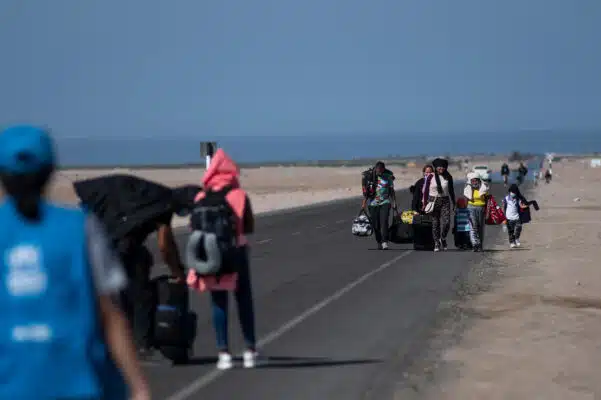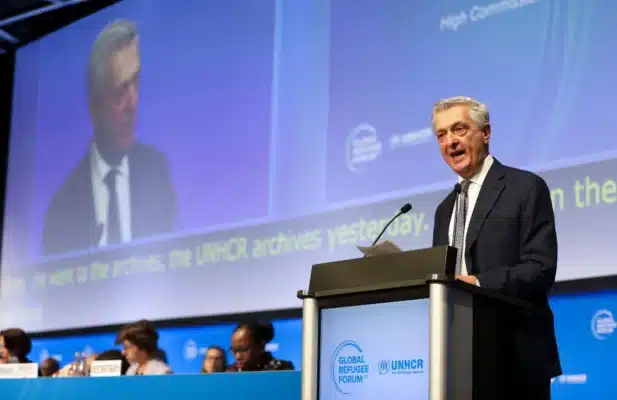
UNHCR’s Filippo Grandi speaks at Georgetown University in Washington, USA, on 3 June. © USA for UNHCR/Nic Feeney
“In Pursuit of the Possible: Addressing population flows in the Americas”
Good afternoon. Thank you, Georgetown University – and in particular the School of Foreign Service and the Institute for the Study of International Migration (ISIM) – for hosting this event, and thanks to students, partners, colleagues and other friends for being here today.
Having been a student myself in Jesuit schools, it means a lot to be here for the first time! It is also a significant moment to be speaking at a university campus – and such a prestigious one at that. Complex and controversial as this may be, what is happening in universities in the United States and around the world proves that young people remain as engaged in international events as ever. This is good, because — and forgive an older man’s remark — there was a perception that such an interest, so prominent in my own youth, was fading. But thankfully and obviously it is not — whether it is about conflicts, climate, rights, justice and other causes. And this is vital if we want the world to remain a vibrant, responsive place at a time of such steep global challenges.
It is of paramount importance that we remain aware of the interdependence prevailing, more than ever, in this same world. What happens within any country can reverberate today almost everywhere else. Please do not forget that this includes the movement of people around our planet — which has always existed, but which in our times has taken dimensions, speed and implications greater and graver than ever before. Elements of this are relevant, of course, to the mandate of my organization, the office of the United Nations High Commissioner for Refugees.
UNHCR deals with a very specific aspect of global human mobility — the forced (and I stress forced) movement of people who flee from war, human rights violations and specific persecutions, increasingly complex forms of violence, and variations on the theme of collapse of law and order. Our latest statistics, which many of you are familiar with, indicate that more than 114 million people have been forced from their homes. We will update this figure in a few days. I’m not allowed to disclose the figure yet, but I can tell you it will be higher. And the toll on those afflicted is — increasingly — exacerbated by another major global challenge: the impact of climate change, very often combined with conflict and inter-communal strife.
Most refugees seek safety close to their own countries and their own homes, hoping for the chance to return. But if they cannot go home, and if there is no viable future where they are now, or if their plight is neglected – well, they will move on.
And they move alongside migrants who are not fleeing war, violence or persecution, therefore who — likely — are not refugees, but who may have other compelling reasons to seek opportunities for themselves and their families, yet have no legal channels to pursue them.
And so is created the phenomenon which we define, with the usual dryness of technical language, one of “mixed movements”: refugees and migrants moving together.
I recognize that the differentiation might sound simplistic or even unnecessary at this stage. People often have multiple and different overlapping reasons to move. A refugee fleeing persecution will also want better opportunities. And poverty or hunger can force migration. However, there are different international legal obligations that apply to how these groups are received by host countries or return to theirs. At the same time, they, both groups, often face similar dangers along the way as they embark on the same journeys. And many vulnerabilities are shared, especially when it comes to women, unaccompanied children, LGBTQI+ individuals, people with specific needs.
Responses to mixed movements therefore require taking into account common challenges faced by people on the move (and the countries they find themselves in), as well as differences and specificities of the groups. And while some politicians are constantly trying to lump them together under the category of generic threats, and to put forward simplistic, brutal solutions to their plight, the reality is that such a complex phenomenon requires equally complex responses.
This is what I would like to focus on today — reflecting and offering suggestions on how to respond to such population flows.
Because this has become a central item in the public debate in almost every country. It is determining the result of elections. It is having an impact on the very fabric of democracy.
Because mixed movements present unprecedented challenges for governments and communities alike.
And above all because at the center of this phenomenon lies the fate of millions — who, in turn, are exposed to unimaginable dangers as they move on.
There is no one solution for all those on the move. But everyone, regardless of their circumstances, has human rights which must be respected. These rights must underpin our collective efforts to respond to their needs.
It is most unfortunate, therefore, that people on the move have become such a pawn in political debates aimed mostly at gaining votes. The rhetoric of migrants and refugees being blamed for everything that is going or has gone wrong in society is familiar: they come to steal jobs; to bring insecurity; to threaten values. Preposterously — but we hear it! — they “invade”. They “substitute”. And — as an inevitable conclusion — there is nothing that can be done to address these population flows except pushing people back, building walls, restricting asylum and migration laws and practices. The more technical proposals that come from such quarters are, in general, simplistic propositions centered on border enforcement as the most effective — if not the only —solution.
Those politicians hope to gain votes and win elections. Meanwhile human beings in dire need of support and protection are blamed, demonized and dehumanized. And the problems are not resolved.
I do not wish to underestimate the real challenge posed by “mixed movements” in Europe, in Southeast Asia, in South Africa, and above all here in North America and especially the United States. But so often we see simplistic responses – they are not just wrong. They are useless. Sustainable solutions are more complex, for sure, and less easy to plan, implement and explain — but they are possible, provided that they are founded on shared responsibility between all states concerned by these flows. However, with some notable exceptions, they are rarely invested in, or even seriously considered. The net results are increased polarization around these themes — and a constant growth of population movements, in numbers and in complexity. And the outcome is often the exact opposite of what is proclaimed: exclusively restrictive and coercive measures mean that the management of populations on the move is often, in effect, being unwittingly outsourced to criminal networks that have readily stepped in to fill the void.
I visited the Colombian side of the Darién last December and I saw this for myself. The extraordinary control waged by criminal networks along the routes — often for lack of better alternatives along the way! — meant that in particular women, unaccompanied children, and elderly people were clearly at their mercy, facing sexual exploitation and violence, extortion, and death. People crossing other locations on this continent, less in the focus of media, such as the Mexico-Guatemala border, face similar dangers and hardship.
These are incredibly difficult challenges. Yet — let me repeat it — we must reject what I call the narrative of impossibility. Let’s not allow ourselves to be overwhelmed by the scale and complexity of these population movements. They are not beyond the reach of real, practical and legal solutions. Quite the contrary; this is the time to ramp up our collective efforts. As I see it, we have that very opportunity here in the Americas — currently hosting every fifth displaced person in the world.
I spend much time visiting governments everywhere. Many are grappling with these challenges. But too often, they only apply piecemeal, border-by-border, deterrence-focused measures that are wholly ineffective and often illegal from the perspective of international law.
Such measures rarely deliver appropriate solutions for refugees and migrants — and they certainly do not deliver results for states.
Furthermore, they endanger the international legal framework that has been a cornerstone for protection and solutions for millions of refugees worldwide over more than seven decades.
Because the key to solve this untenable situation in the Americas will not be found along the 2,000-mile-long Southwest border of the United States. There is also no quick fix hidden in the Darién, in Mexico or somewhere in the southern cone of this continent.
This is why the main objective of my talk today is not so much to recall what has gone wrong – rather, to highlight opportunities for solutions.
Such solutions can only be found if we step back and take a view which I have often defined as “panoramic”. Comprehensive, collaborative, and bespoke for this region.
While migration and border controls are necessary and a country’s sovereign right, we need a more ambitious, strategic approach that incorporates several interdependent elements. Like a menu of mutually reinforcing options, they need to be pursued in parallel in multiple locations — in regions of origin, transit, destination and return; and they will involve all states affected with the participation of many other parties.
The good news is that we can build on the excellent work already undertaken by several governments in this region, along with international organizations, development actors, civil society, the private sector and not least refugees and migrants themselves. We must also avail ourselves of the solutions offered by the 2018 Global Compact on Refugees (and its twin, the Global Compact on Safe and Orderly Migration). And let us not forget that the refugee compact is built over the important foundations of the 1951 Refugee Convention, and the 1984 Cartagena Declaration, which was so forward looking in respect of refugee protection in this hemisphere and of which we celebrate the 40th anniversary this year.
These multiple tracks can of course be presented in many different ways. Let me divide them for the sake of clarity into four broad areas.
First and foremost, the most obvious but also the most difficult: we must address the root causes of population flows. This means resolving conflicts, improving security, reinforcing governance and human rights, providing sustained financial support to boost growth and resilience in countries of origin — steep challenges, which of course need to be elaborated upon separately. But in short, what is needed — from the perspective of population flows — is investing in people’s futures in their own countries so they have the option to remain in their communities and to thrive there, without being compelled to move by either violence or poverty — or both.
But action on this front is fraught with challenges, mostly of a political nature. It is important that we remain focused on solving crises — and I briefed the Security Council on Thursday, highlighting the link between conflicts and forced displacement — but we must assume that meanwhile, while we try to solve crises, millions of people will have no choice but to flee. If you look at the places of origin of many of the people on the move in the Americas — Haiti, Nicaragua, Venezuela, and other countries in Central America — you will appreciate that each one of them is facing challenges of an extraordinary political and economic complexity. Without addressing those (and other) problems it will be very difficult to witness a slowdown or decrease of population flows.
The second element of this big jigsaw is the consideration that not all, but many people on the move cross borders in search of safety. This factor is sometimes downplayed, as it triggers obligations, but it is a very real and frequent one. And it is most important for UNHCR obviously as it means — essentially — that people in this situation must be granted access to territory to seek asylum, and that asylum systems along the routes must be strong and effective.
This is at the heart of my organization’s mandate. Denial of the right to seek asylum is a violation of international law. This does not mean that states must give everyone the right to stay, but those who need it must have the chance to make their case.
We must promote a concerted push for further development of fair and efficient asylum and protection systems throughout the Americas. Indeed, a core part of UNHCR’s contribution to a panoramic, hemispheric approach is to work alongside governments and civil society actors to build systems which can identify — quickly and fairly — those who are in need of international protection and provide them with appropriate solutions.
We have much to offer when it comes to building national asylum systems that are both fair and efficient. It is no secret that we have serious concerns about restrictive measures applied – and seemingly and worryingly under consideration – by the United States and also by other governments. There are principled and practical ways to eliminate inefficiencies and address backlogs through innovative tools such as differentiated case processing and accelerated procedures. Asylum applications do not need to be assessed in chronological order, which often leaves people waiting for years to have their case heard. Instead, UNHCR can help states develop tailored procedures and better targeting of resources. The result is less pressure on national systems which also means less backlogs. We are encouraged that such measures — already underway in some countries such as Brazil, Canada, Mexico and Uruguay — are under consideration in other countries, including the United States, where these reforms as we all know are most urgently needed.
It is also worth recognizing how the Western Hemisphere has paved the way for alternative legal stay arrangements, including for refugees. These have proven to be a significant complement to traditional asylum, providing temporary protection and generating inclusion opportunities for displaced people, while also benefiting the communities that host them. Best practices in the Americas have mainly addressed the needs of Venezuelans — such as in Colombia, Ecuador, Peru and Brazil, as well as here in the United States. There are opportunities to expand these regularization efforts— also to encompass other nationalities — with even greater impact.
States can only gain from stronger asylum systems as this will also allow them to arrange for the return in safety and dignity of people found not to be in need of protection and who do not have another basis to remain. This issue is, by definition, on the periphery of my mandate. But it needs to be stated clearly: while UNHCR will remain resolutely opposed to any deportation of asylum seekers whose claims have not been properly carried out, or to any forcible return to countries in situations of grave instability, such as Haiti for example — and we have made this clear to the US Administration among others — on the other hand returns carried out humanely, after a proper assessment of the merits of an asylum claim, are critical to uphold public trust in the asylum process, and ultimately necessary to ensure that those in need of protection are granted asylum.
There is also potential to arrange for readmission to a country “upstream” on the route (so to speak) of a person who had previously enjoyed protective legal status there. This can be part of collaborative agreements between countries which should include appropriate safeguards, so that people are returned to situations where their rights are respected and where there are opportunities to achieve stability.
The third element is a broader one, straddling across the refugee/migrant spheres, and encompassing a wide range of interventions aimed at helping countries along the routes address immediate and long-term challenges linked to the presence of people on the move — from humanitarian needs to inclusion and integration where they are possible. This is really about building the capacity of states and creating opportunities for refugees and migrants, ensuring always that host communities benefit from those interventions — and in so doing, allowing for population flows to be stabilized in a manner that is legitimate, sustainable and also beneficial to countries along the routes.
To achieve this, strong partnerships are needed: host countries must establish sound policies to ensure that legal status and access to services and livelihoods are accessible for those who qualify — some do: it was a privilege for me to personally witness, for example, Colombia’s public adoption of a very forward-looking temporary protection regime. To support this, donor governments and international financial institutions must recognize these courageous efforts and provide — in addition to humanitarian aid in case of crisis — the development resources needed to implement inclusive public policies that can facilitate integration — through investments, for example, in schools and universities, health systems, businesses, markets, trade, and environmental projects. Where this happens, host communities actually gain. For example, according to an IMF study, in Chile, Colombia, Ecuador and Peru, the flows from Venezuela, and the human capital they bring in terms of labour supply and tax revenue, contribute to GDP growth.
In this equation, undoubtedly the real difference-maker will be development financing through international financial institutions like the World Bank or the Inter-American Development Bank, or bilateral agencies like USAID.
And of course, private sector investments will also be crucial, especially in creating work opportunities. In several Mexican cities, for example, I have visited extraordinarily successful integration projects for Central American refugees, largely driven by business — There is still a lot of work to be done, but if brought up to scale, they can be the biggest game changer.
We at UNHCR will continue to promote such investments, and work closely with the International Organization for Migration, IOM, whose focus is on orderly and safe migration. We are both making great strides in including refugee and migrant populations in thought processes and planning related to development and investment opportunities. As I see it, this hemisphere has the potential to lead the way in how we pursue collective efforts to yield stability and prosperity for both host communities and displaced populations.
If opportunity is on offer, people will take it!
And last, but certainly not least, is the fourth element – the need for increased alternative pathways to third countries for refugees and migrants, including refugee resettlement. These options exist, but they remain very limited in comparison with the overall needs, and — frankly — are not yet a competitor for traffickers and smugglers.
Safe pathways are important for refugees and people in need of international protection. But they are also crucial to provide channels for safe and orderly migration, which again— if available at scale, substantive and well functioning — can relieve pressure on clogged and overused asylum systems, often seen by migrants as the only option to enter a country.
Regarding this element I would be remiss not to acknowledge US leadership, significantly reinvigorated in recent years, not only in the region but also globally. Resettlement for refugees, visas for family reunification, education or work, seasonal employment opportunities, parole channels, as well as access to private sponsorship programmes like the one implemented by Canada and also the Welcome Corps here in the US — all provide safe, orderly alternatives to risky, irregular travel.
The Safe Mobility Offices initiative for example is an impressive feat of collaboration between the US Administration, several key host countries, IOM and UNHCR towards setting up a one-stop-shop mechanism for resettlement and migration pathways in multiple countries in a matter of months. Together, we have achieved a proof of concept! But to reach its full potential, this initiative needs to be broadened to reach further eligible populations and must be part of a comprehensive ecosystem of well-coordinated efforts.
It is crucial, let me add this point, that these pathways are not used as trade-offs to access to asylum at borders — something that must be safeguarded— but as an additional important element in the bigger effort to manage population movements effectively. This is an issue which we have repeatedly raised — not always successfully — with the US Administration.
It is easy to understand how interdependent these four elements are. Therefore, the “my country first” approach which prevails in the rhetoric of so many politicians, and of some governments, will not be useful to achieve them: on the contrary, cooperation and genuine responsibility-sharing between governments are essential.
The time is ripe to build a comprehensive, hemispheric approach that includes the essential and interlocking elements of an ecosystem of responses. These various “route-based approaches” must be pursued simultaneously, whether here across the Americas or along other routes in other regions, with the participation of an array of actors. If we act in isolation, if we focus solely on deterrence, the impact will be short-lived. All the pieces of the puzzle need to be in place, or else the puzzle will not be solved, and the picture will be incomplete.
To achieve this, we need a common understanding of what a comprehensive response that always keeps solutions in sight should be – a joint vision for the way forward, to be pursued boldly, and together. I would like to see leaders in the region be brave enough and instead of constantly focusing on how to improve controls and restrictions, embrace a collective, principled, comprehensive, sustainable vision on how to move forward to solve problems at all stages of this complex phenomenon and in all countries crossed by those painful journeys.
To move forward along all four tracks, cooperation is key. Arrangements between states must be put in place. This will require overcoming the deep political divergences existing among countries in the Western Hemisphere — difficult, but not impossible. Last month’s ministerial meeting in Guatemala, following up on the 2022 Los Angeles Declaration on Migration and Protection, was encouraging, for example. Many of us felt that there was a growing convergence of views about the challenges of human mobility and the need to address them together in spite of political divisions. There are other multilateral fora that foster dialogue between states in the region. Specialized organizations like UNHCR and IOM are ready to support and cooperate. This means that we also need a strong framework for the engagement of UN agencies, international financial institutions, NGOs and other stakeholders – ensuring meaningful participation by refugees and migrants – bringing together both humanitarian and development actors in pursuit of comprehensive and strategic responses.
Such efforts, dear friends, are long overdue. No magic wand will solve these problems, and we may not get immediately to ideal outcomes for all the challenges. But together, if we take a step back and consider all the pieces of the puzzle and how they fit together, I am confident that we will be better able to protect lives and see more benefits for all, including the states concerned.
We need the courage to innovate, and the resolve to cooperate, for a hemispheric approach that is comprehensive, effective, and compassionate.
It is going to be a long and fraught journey — but if there is a will, there is a way.
Thank you.





